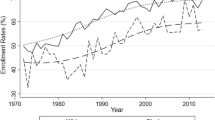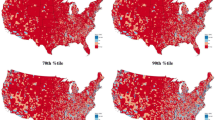Abstract
This study uses fixed-effects panel data techniques to estimate the elasticity of community college enrollment demand relative to local unemployment rates. The findings suggest that community college enrollment demand is counter-cyclical to changes in the labor market, as enrollments rise during periods of weak economic conditions. Using national data for the years 1990 through 2009, we find that a one percentage-point change in unemployment is associated with 1.1–3.3 % increases in enrollment demand. We disaggregate the analysis by total full-time and part-time enrollment, concluding that high levels of unemployment are also associated with greater demand for full-time attendance. Additionally, enrollments are slightly more responsive to unemployment in metropolitan (rather than micropolitan) areas. Informed by enrollment demand theory, our analysis provides an update to the “unemployment elasticity” literature and could aid in current enrollment planning, economic development, and public policy efforts to educate students on the margin between college and work.

Similar content being viewed by others
Notes
.This period of time incorporates four recessions. For a full list of U.S. recession periods, see National Bureau of Economic Research (2012).
These years represent the earliest and latest available data periods.
We conducted a Hausman specification test, rejecting the null hypothesis that the random effects are orthogonal to the regressors. As a result, the fixed-effects method is preferred.
References
Allison, P. D. (2009). Fixed effects regression models. Sage series on quantitative applications in the Social Sciences.
Becker, W. (1990). The demand for higher education. In S. Hoenack & E. Collins (Eds.), The economics of American universities: management, operations, and fiscal environment (pp. 155–188). New York: SUNY.
Becker, G. S. (1993). Human capital: a theoretical and empirical analysis, with special reference to education. Chicago: University of Chicago Press.
Betts, J. R., & McFarland, L. L. (1995). Safe port in a storm: the impact of labor market conditions on community college enrollments. The Journal of Human Resources, 30(4), 741–765.
Black, S. E., & Sufi, A. (2002). Who goes to college? differential enrollment by race and family background. Cambridge: National Bureau of Economic Research.
Bozick, R. (2009). Job opportunities, economic resources, and the postsecondary destinations of American youth. Demography, 46(3), 493–512.
Clotfelter, C. T. (1992). Explaining the demand. In C. Clotfelter, R. Ehrenberg, M. Getz, & J. Siegfried (Eds.), Economic challenges in higher education (pp. 59–88). Chicago: University of Chicago Press.
Cohen, A., & Brawer, F. (2008). The American community college (5th ed.). Hoboken: Wiley.
Corazzini, A. J., Dugan, D. J., & Grabowski, H. G. (1972). Determinants and distributional aspects of enrollment in US higher education. Journal of Human Resources, 7, 39–59.
Dadashova, A., Hossler, D., & Shapiro, D. (2011). National postsecondary enrollment trends: before, during, and after the great recession. Herndon: National Student Clearinghouse.
Dellas, H., & Sakellaris, P. (2003). On the cyclicality of schooling: theory and evidence. Oxford Economic Papers, 55(1), 148.
Drukker, D. (2003). Testing for serial correlation in linear panel-data models. The Stata Journal, 3(2), 168–177.
Elsby, M., Hobijn, B., & Sahin, A. (2010). The labor market in the great recession. Brookings papers on economic activity. Washington, D.C.: Spring.
Feldman, P., & Hoenack, S. (1969). Private demand for higher education in the United States. The economics and financing of Higher Education in the United States, 375–95.
Fitzpatrick, M., & Turner, S. (2007). Blurring the boundary: changes in the transition from college participation to adulthood (pp. 107–137). The Price of Independence: The Economics of Early Adulthood.
Goldin, C. D., & Katz, L. F. (2008). The race between education and technology. Cambridge: Belknap.
Heller, D. E. (1997). Student price response in higher education. The Journal of Higher Education, 68(6), 624–659.
Hemelt, S. W., & Marcotte, D. E. (2011). The impact of tuition increases on enrollment at public colleges and universities. Educational Evaluation and Policy Analysis, 33, 435–457.
Hoenack, S. A., & Weiler, W. C. (1979). The demand for higher education and institutional enrollment forecasting. Economic Inquiry, 17(1), 89–113.
Jackson, G. A., & Weathersby, G. B. (1975). Individual demand for higher education: a review and analysis of recent empirical studies. The Journal of Higher Education, 46, 623–652.
Kane, T. J. (1994). College entry by blacks since 1970: the role of college costs, family background, and the returns to education. Journal of Political Economy, 102, 878–911.
Kane, T. J. (1999). The price of admission: rethinking how Americans pay for college. Washington, D.C.: Brookings Institution.
Kane, T. J., & Rouse, C. (1999). The community college: educating students at the margin between college and work. The Journal of Economic Perspectives, 13(1), 63–84.
Katz, L. (2010). Long-term unemployment in the great recession. Testimony for the joint economic committee of the US Congress hearing on “Long-Term Unemployment: Causes, Consequences and Solutions”(April 29, 2010).
Kienzl, G., Alfonso, M., & Melguizo, T. (2007). The effect of local labor market conditions in the 1990s on the likelihood of community college students’ persistence and attainment. Research in Higher Education, 48(7), 751–774. doi:10.1007/s11162-007-9050-y.
Leigh, D. E., & Gill, A. M. (2007). Do community colleges respond to local needs?: evidence from California. Kalamazoo: W.E. Upjohn Institute.
Leslie, L. L., & Brinkman, P. T. (1987). Student price response in higher education: the student demand studies. The Journal of Higher Education, 58, 181–204.
Levin, J. (2007). Nontraditional students and community colleges: the conflict of justice and neoliberalism. Basingstoke: Palgrave Macmillan.
Levine, L. (2011). Economic growth and the unemployment rate. Congressional Research Service, 7–75700, Washington, D.C.
Lewin, T. (2012). Obama budget seeks job training at community colleges. The New York Times. http://www.nytimes.com/2012/02/14/education/obama-to-propose-community-college-aid.html. Accessed 18 Feb 2012.
Manski, C. F., & Wise, D. A. (1983). College choice in America. Cambridge: Harvard University Press.
Mullin, C., & Phillippe, K. (2009). Community college enrollment surge. AACC policy brief series. Washington, D.C.: American Association of Community Colleges.
National Bureau of Economic Research (2012). U.S. Business cycle expansion and contractions. NBER. http://www.nber.org/cycles.html. Accessed 24 Jan 2012.
Nutting, A. W. (2008). Costs of attendance and the educational programs of first-time community college students. Economics of Education Review, 27(4), 450–459.
Pindyck, R., & Rubinfeld, D. (1997). Econometric models and economic forecasts (4th ed.). Columbus: McGraw-Hill/Irwin.
Rivkin, S. G. (1995). Black/white differences in schooling and employment. The Journal of Human Resources, 30, 826–852.
Rouse, C. E. (1994). What to do after high school: The two-year versus four-year college enrollment decision (pp. 59–88). Choices and consequences: Contemporary policy issues in education.
Rusk, J. J., Leslie, L. L., & Brinkman, P. T. (1982). The increasing impact of economic conditions upon higher education enrollments. Economics of Education Review, 2(1), 25–48.
Schultz, M. (2010). Federal funding cuts will limit no worker left behind. The Detroit News. http://www.detroitnews.com/article/20100630/BIZ/6300356. Accessed 3 Feb 2012.
Stratton, L. S., O’Toole, D. M., & Wetzel, J. N. (2004). Factors affecting initial enrollment intensity: part-time versus full-time enrollment. Economics of Education Review, 23(2), 167–175. doi:10.1016/j.econedurev.2003.06.002.
Summers, L. H. (2010). Principles for economic recovery and renewal. Business Economics, 45(1), 3–7.
U.S. Bureau of Labor Statistics (2012). Employment situation summary. http://www.bls.gov/news.release/empsit.nr0.htm. Accessed 27 Feb 2012.
U.S. Census Bureau (2012). Metropolitan and micropolitan, metropolitan and micropolitan statistical areas. http://www.census.gov/population/metro/. Accessed 9 Feb 2012.
U.S. Department of Education (2011). Digest of education statistics, 2010. Digest of education statistics. http://nces.ed.gov/programs/digest/d10/tables/dt10_34.asp. Accessed 3 Nov 2011.
Wooldridge, J. M. (2009). Introductory econometrics: a modern approach. Belmont: Cengage Learning.
Author information
Authors and Affiliations
Corresponding author
Rights and permissions
About this article
Cite this article
Hillman, N.W., Orians, E.L. Community Colleges and Labor Market Conditions: How Does Enrollment Demand Change Relative to Local Unemployment Rates?. Res High Educ 54, 765–780 (2013). https://doi.org/10.1007/s11162-013-9294-7
Received:
Published:
Issue Date:
DOI: https://doi.org/10.1007/s11162-013-9294-7




